
Uniqueness
“I’m the biologist here, and I can tell you that cloning is bad!”
You’d be surprised at how many debates come up in the R&D room. We have a common passion for games, but our past work experience and education have been quite different. Whether it is the former game store manager, or the former game store retailer, or the former slacker, there’s always an opinion. When it comes to college majors represented in-house, the philosophers seem to have a stranglehold here. Having a background in biology isn’t quite the tool that some of the others have when it comes to these debates.
Occasionally, however, there’s that moment for my knowledge to shine . . .
As you know, characters in our game are unique (unless they have the version “Army”). The rule for uniqueness is that, as part of resolving the recruit effect of a unique character, uniqueness puts each other object you control with the same name as that character into its owner’s KO’d pile. This is one of the central rules in our game. But rules are often fun for players and designers to break.
Thematically, there are several reasons to justify cheating the uniqueness rule. There are many examples of characters being cloned or exisiting concurrently via time travel. I give the designers some leeway in exploring this theme by breaking uniqueness in our game, but I have been known to plead for moderation in these areas by citing my dissertation on reproductive cloning, which, in a nutshell, suggests that cloning is not all it’s cracked up to be.
All silliness aside, there is nothing wrong with cloning in our game, per se, other than that it limits what we can do with characters when we can’t rely on only one of them being in play. And surprisingly, it isn’t just an issue of a single version of a card. While we have to be careful that players cannot easily duplicate an effect like that on Beast, Dr. Henry McCoy given the presence of cards like Gamma Bomb, it is also a constraint on making powerful different versions for a given character that would synergize a little too well together. Let’s just say that there were times when I thought that someone getting Dr. Doom, Diabolic Genius and Dr. Doom, Victor Von Doom into play at the same time would be the end of the world. However, there are enough hurdles for a player to get to this position that it has turned out to be fine within our game.
To date, we have still tried to be conservative with ways to get around uniqueness on characters. The more open-ended the effect, the more conservative we have to be.
Besides spelling out that a card is not unique, we have many other methods of putting duplicate character cards into play; these get around uniqueness on characters because uniqueness is checked on resolving a recruit effect, not when the character comes into play. This is a tool we’ve relied on extensively to allow multiple copies of a character with the same name to enter play. When we don’t want that character to get around the uniqueness rule, we generally attach the game text “. . . if you do not control a character with the same name.”
Who Can be Cloned?
We have a few classes of cards that can break uniqueness. Self-referencing cards are the easiest to test from a developer’s perspective. These are cards with “Army,” or cards like the various Kangs, which read, “Kang is not unique.” We know from the outset what we are getting into with these cards.
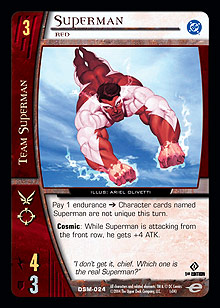 The next broader range of cards are those that reference a subset of cards. The most common example of this is for our iconic characters who’ve eluded their uniquness restriction via cards like Superman, Red; Look-Alike Squad; Cadmus Labs ; and Scarlet Spider, Ben Reilly. We have to keep these cards in mind any time we make a new Spider-Man or Superman.
The next broader range of cards are those that reference a subset of cards. The most common example of this is for our iconic characters who’ve eluded their uniquness restriction via cards like Superman, Red; Look-Alike Squad; Cadmus Labs ; and Scarlet Spider, Ben Reilly. We have to keep these cards in mind any time we make a new Spider-Man or Superman.
Yet other cards have opened up the possiblities for a specific subset of our cardpool. For example, Changeling and Fisk Towers each allow 1-cost characters to run amok. Jackal, Dr. Miles Warren ups the ante to 3-cost characters. Dark Embrace opens things all the way up to 7-cost characters. Fifth Dimension opens up the possibilities for an entire team.
Then there are the cards that are for all intents completely open-ended. It was very early in our game’s history that two of these cards hit the scene; DC Origins unleashed Dr. Light, Arthur Light and Dual Nature. In our newest set, Infinite Crisis, Lex Luthor, Mockingbird provides yet another tool to the would-be cloner out there.
Locations
Locations are also unique in our game. As part of flipping a unique location, the uniqueness rule puts each other object you control with the same name as that location into its owner’s KO’d pile.
There are many locations with the text, “<Cardname> is not unique.” The League of Assassins was the first team to have an abundance of such locations with the likes of Mountain Stronghold and Lazarus Pit. There hasn’t been as much of a middle ground in breaking location uniqueness as there has been for characters. In fact, there’s one man and one man alone who holds the key to breaking apart this rule—Ra’s al Ghul, The Demon’s Head—and he does so in a very thorough way.
Equipment
Unlike characters and locations, equipment is not unique by default, but it is allowed to have the unique characteristic. Equipment in our game has received the “unique” tag almost entirely for thematic reasons. This has been applied to iconic equipment for which only one copy has existed at any point in time. With this in mind, we have tried to push the limits on what such equipment can do, given that they are marquee equipment cards that have the restriction inherent to uniqueness.
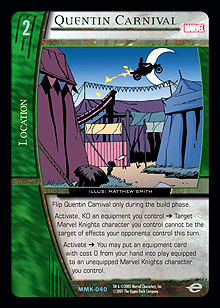 To date, uniqueness has been checked on equipment in the same way that it has been checked on characters—upon resolution of the recruitment. We made a number of cards that put equipment into play without recruiting them, which in hindsight wasn’t optimal, since it left a loophole for getting multiple copies of these unique equipment cards into play. The cards I’m speaking of include Black Panther, King of Wakanda; Punisher, Jury; John Henry Irons ◊ Steel, Steel Drivin’ Man and Quentin Carnival.
To date, uniqueness has been checked on equipment in the same way that it has been checked on characters—upon resolution of the recruitment. We made a number of cards that put equipment into play without recruiting them, which in hindsight wasn’t optimal, since it left a loophole for getting multiple copies of these unique equipment cards into play. The cards I’m speaking of include Black Panther, King of Wakanda; Punisher, Jury; John Henry Irons ◊ Steel, Steel Drivin’ Man and Quentin Carnival.
Unlike the vast majority of the cards I pointed out above that get around uniqueness, the goal of these equipment-related cards wasn’t to dodge equipment uniqueness. While we were aware that this interaction existed, we didn’t feel that there was a “problem” to the point where we wanted to add another line of text to these cards like we had done for the characters; in this case, something like “. . . if you do not control equipment with the same name.” And since we’d probably want you to put out a second copy of something like Advanced Hardware, it would be something more like “. . . if you do not control a unique equipment with the same name.” And even that leaves loopholes and rules confusion over unique equipment in play on a stunned character.
As many of you know, the interaction of the unique Fate Artifacts is very powerful when they are not unique, especially Amulet of Nabu. Rather than reacting to this situation with errata on the Artifacts or on the earlier cards that put equipment into play, we are finally taking this as an impetus to fix the rules, thereby eliminating the violations of equipment uniqueness that we had never intended as a function of those cards. This will also allow us more space to keep pushing the power level on future unique equipment—like, say, for a handful of related equipment in the Heralds of Galactus set . . .
Consequently, we are changing the uniqueness rule on equipment to check when the equipment becomes attached to a character rather than when it comes into play.
From the updated Comprehensive Rules, we have:
705.3 As part of attaching a unique equipment to a character, that character’s controller puts each other object he or she controls with the same name as that equipment into its owner’s KO’d pile. This is not the same as KO’ing those objects.
The rules for uniqueness on locations and characters work as before. In a general sense, we now have uniqueness check on flipping locations, recruiting characters, and attaching equipment.
“Once Per Turn” and Combos
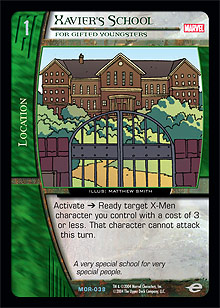 One of the most worrisome things for a game developer is the existence of an infinite loop within our game. In general, an infinite loop will occur when you have a set of cards whose effects generate the means to pay all of the costs on that same set of cards. For example, let’s imagine for a moment that Black Thorn does not have a once-per-turn restriction on her activated power. If you were then to give her the X-Men team affiliation and had Xavier’s School for Gifted Youngsters in play, you could ready her an infinite number of times. The costs on this pair of cards are to activate a given location and a given character, and the effects are to ready a given location and a given character. And so, a loop is born. Loops generated by a pair of cards are generally easier for us to spot than those created over a larger series of cards. While this loop generates nothing game-breaking in and of itself, most loops are going to interact with some other card we’ve already made. In this particular example, any card that rewards the activation or exhaustion of a character or a location would give us problems. And so, a card like Madame Web, which would give you infinite endurance, is a third piece in this puzzle.
One of the most worrisome things for a game developer is the existence of an infinite loop within our game. In general, an infinite loop will occur when you have a set of cards whose effects generate the means to pay all of the costs on that same set of cards. For example, let’s imagine for a moment that Black Thorn does not have a once-per-turn restriction on her activated power. If you were then to give her the X-Men team affiliation and had Xavier’s School for Gifted Youngsters in play, you could ready her an infinite number of times. The costs on this pair of cards are to activate a given location and a given character, and the effects are to ready a given location and a given character. And so, a loop is born. Loops generated by a pair of cards are generally easier for us to spot than those created over a larger series of cards. While this loop generates nothing game-breaking in and of itself, most loops are going to interact with some other card we’ve already made. In this particular example, any card that rewards the activation or exhaustion of a character or a location would give us problems. And so, a card like Madame Web, which would give you infinite endurance, is a third piece in this puzzle.
Let’s take one more example. Let’s say we had not errata’d Rama-Tut to: “When Rama-Tut comes into play, if you recruited him and you control Dr. Doom, you may return target plot twist card from your KO’d pile to your hand.” When Hard Sound Construct came onto the scene, we’d have had effects for returning a plot twist from your KO’d pile to your hand and for putting a 2-cost character from your KO’d pile into play. The costs on the cards are putting a 2-cost character into play and playing a plot twist. The only piece missing is a way to put the 2-cost character into your KO’d pile from play repeatedly. As it turns out, Devil’s Due not only allows you to do just that, but it also gives you your path to victory by putting +1 ATK / +1 DEF counters on your characters as part of the process.
As developers, we look for interactions like these all of the time. Most of these interactions could be solved by having a once-per-turn restriction on key cards. With cards that we suspect are likely to fit into such engines by regenerating the means to pay the costs on other cards, we can take this measure as a safeguard. Whenever possible, however, we don’t want to put that restriction on cards because it can add a line of game text and limit the open-endedness of the play experience. If we were to put “use this power only once per turn” on every activated power, it would severely limit what players could do with some effects that ready characters. It also looks awkward to have a character with an activated power like Black Thorn say “once per turn” when that is sort of what activated powers are supposed to entail. However, it can become a necessity to avoid loops like the ones above.
Sadly, the restriction in the particular case of Black Thorn was still not enough to save us this time. There is a way to get around the once-per-turn restriction by repeatedly returning her to play from your KO’d pile with Dr. Light, Master of Holograms, since each time she returns, she is no longer considered to be the same character that has already used her activated power. So, you could ready Dr. Light, Master of Holograms instead of her with Xavier’s School for Gifted Youngsters.
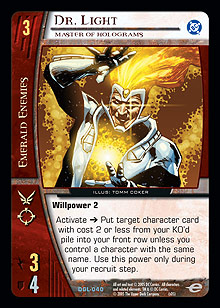 This interaction was the final straw that led to the errata of Dr. Light to: “Activate >>> Put target character card with cost 2 or less from your KO’d pile into your front row if you don’t control a character with the same name as that card. Use this power only once per turn and only during your recruit step.” However, it wasn’t just the Black Thorn interaction that caused us to act. For instance, Dr. Light can keep bringing back Tomorrow Woman; you give her to your opponent, then name her with Daily Bugle, then stun her with Cardiac, then flip down Cosmic Radiation with the Daily Bugle’s effect, and then return her to the KO’d pile with something like Total Anarchy or War Wagon for Dr. Light to bring back anew with the refreshed Cosmic Radiation. Yes, this is complicated, but so was the original Light Show deck.
This interaction was the final straw that led to the errata of Dr. Light to: “Activate >>> Put target character card with cost 2 or less from your KO’d pile into your front row if you don’t control a character with the same name as that card. Use this power only once per turn and only during your recruit step.” However, it wasn’t just the Black Thorn interaction that caused us to act. For instance, Dr. Light can keep bringing back Tomorrow Woman; you give her to your opponent, then name her with Daily Bugle, then stun her with Cardiac, then flip down Cosmic Radiation with the Daily Bugle’s effect, and then return her to the KO’d pile with something like Total Anarchy or War Wagon for Dr. Light to bring back anew with the refreshed Cosmic Radiation. Yes, this is complicated, but so was the original Light Show deck.
When all was said and done, we felt we had to put an end to the open-endedness of Dr. Light, and having him contained to once per turn seemed like the most reasonable fix. With the release of the Infinite Crisis expansion, it actually seems somewhat fitting that Dr. Light finally received this lobotomy.
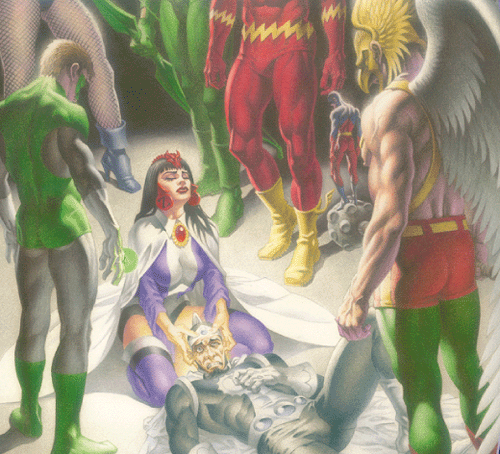
Free or Nearly Free
To address the final change, let’s look at the other recent errata we’ve made with the release of the new set—Adam Strange.
His new wording is:
“Reveal Adam Strange >>> If Adam Strange is in your resource row, KO target character with cost 1. If you do, KO Adam Strange and you may put a card from your hand face down into your resource row. Use this power only once per turn, only if Adam Strange is in your resource row, and only during the recovery phase.”
Ordinarily, a card like this would have “KO Adam Strange” as part of the cost rather than as part of the effect. However, we chose to be very careful that a player would not end up down a resource if the card were negated. In doing so, the cost of the card became really not much of a cost at all.
In brief, we went with this exact wording because:
1) We didn’t want him to be able to KO any number of 1-cost characters by revealing him repeatedly.
2) We wanted there to be a point of interaction with this card. For example, if you use Adam Strange’s power and your opponent responds with something like Swift Escape, we don’t simply want you to be able to respond to that effect again with Adam Strange’s power (or any other such effects).
I hope that this brings you up to date on all the recent card and rules changes we’ve made. And with any luck, I won’t need to write any more articles on Dr. Light in the near future.
Comments are welcome at DHumpherys@Metagame.com.